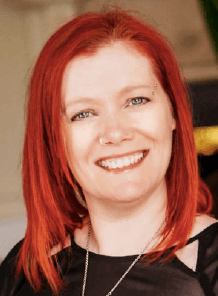
I don’t know what percentage of VO work is done internationally in the current market, but it’s a lot. Personally, 80% of my voice work is for clients outside my home and native land, eh? Whether you’re an expat working for the US market back home, or live on here but are accessing work abroad, bridging the gap between home and away takes finesse. Shelley Avellino knows that more than most. A Brit from Wales who’s been living abroad (in the US and Hong Kong) most of her adult life, she’s just launched a new service to voice over artists helping us navigate customs and costing and clients, oh my.
A casting director for Sweetrush, and director and performance coach at Melissa Moats’ Voice Over Studio in Las Vegas and a terrific talent herself, Shells was on her way from Vegas to London today for the One Voice conference, but I caught her for a few minutes to shed light on her new site and service.
Kim: What led you to create Bridging the VO Gap and offering the service you do?
Shelley: I’d been thinking about doing it for a very long time. I actually have to thank Tom Test for this because six years ago at my very first FaffCon, he was doing a talk on International voice work and said “Hey Shell, you’re foreign, why don’t you be part of my talk and tell people what you do?” And I did and after a lot of people approached me saying, “I didn’t even think about looking abroad for work.” To me it was normal and I thought everybody was doing it, but of course they weren’t. So, I began writing all the information I had and have been gathering for the last six years or so properly and put it together to be able to help other voice actors realize that they don’t have to just stick to their own back yard. There’s so much work out there, but they may not know exactly where to start. SO Bridging the VO Gap is a great way for people to know there’s somebody out there who’s been there, done that, got the T-Shirt, learned sometimes the hard way and can give people guidance on what mistakes to avoid.
Why You Should Go International with Your Voice Over
Kim: There are a few moving parts to going international with your voice over work? What are they?
Shelley: Exactly. It’s just like when you market yourself here. You may have an agent, may belong to a Union, and get a lot of work that way and don’t do a lot of self-marketing and that’s great. But for those who don’t have that or rely on Pay2Play sites, again you’re limited, you may get jobs from P2Ps, but not clients. Clients are a little more hard to come by. So, for those who are not Union and not relying on P2Ps, international marketing is a great way to start, and the first “moving part” is where. Where do I even start looking? ‘Cause the world’s big, right? It can be quite scary to know what to do, where to begin. So, I help people break it down. Where do I look, where are the good resources, search engines, how do I get around that. And then we move on to how do I contact these clients. People speak different languages and have different customs, so you have to navigate that moving part. And then once you’ve booked a job in say, Italy, it’s what voice over rate do I charge, do they do usage, how do they do business, how do they talk to their clients, what’s the best way to contact them? So it’s all those moving parts, knowing different currencies, different time zones, all that kind of stuff.
 Kim: Theses are one-on-one lessons over Skype or Zoom, right? Without revealing the info you give away in your sessions, what can participants expect to get, in a nutshell?
Kim: Theses are one-on-one lessons over Skype or Zoom, right? Without revealing the info you give away in your sessions, what can participants expect to get, in a nutshell?
Shelley: Yes, Skype or zoom and the reason I’m doing them one-on-one is that everybody’s journey is different and I want to be able to tailor it to best fit each person’s needs. What I do covers so much, some people might only want info in one area, they might already be marketing abroad, but they want to expand and they don’t know how to find rate cards for certain countries, or other aspects they want me to cover with them. Or it might be they’ve got a live directed session with someone in another country and they’re not sure of themselves. I do performance coaching as well, which is something I love to do and I always give a little bit of insight into customs of say live sessions in France, or China, or Singapore, or India, because it is very different. They deal with clients and business in different ways. I can go quite in-depth depending on what someone’s needs are, or I can give a broad outline. It really depends, it’s kind of bespoke.
Diving into International Voice Over Rates and Customs
Kim: The world is wide and there is so much cultural diversity. You dive into voice over international rates and customs in your course. You must have put a lot of research into the various markets. How did that happen?
Shelley: That was a bit of a task. It’s all right getting voice over rates from production companies and Unions in specific countries, but if there’s a South African client, for instance, how am I going to get rates for that country? I decided the best way to get an indication of rates in various countries was to reach out to the voice over talent themselves. So, I spent a long time over many years building this info and getting input from more than one VO actor in each region and building up my rate sheets that way.
Kim: Who do you think will best benefit from working with you?
Shelley: I think somebody who’s been in the craft for maybe a couple of years and just wants to branch out to get new clients. People new to the industry can get an overview of what’s out there, so really most people can get something out of Bridging the VO Gap. Even those who’ve been at it for years and years, because guess what? They may have a couple of areas they work at outside of where they live, but they may not know about certain directories or certain places to go for usage rates, or sweet little websites to be aware of. So, I’d say probably everyone could find something of value.
Kim: Is a one-hour session sufficient? Or if voiceover artists want to really take on the world, do they need more time with you?
Shelley: I’ve done a bit of both with people. Again, it depends on what they need. Some people may only need an hour, and some may come back to me and say, ok, I’ve got a handle on this, now I’d like more insight into listing on certain websites, currency or payment issues. An hour is good to get the basics or work on something specific. And if someone wants to work with me on voice over performance afterwards, I’m totally down for that.
